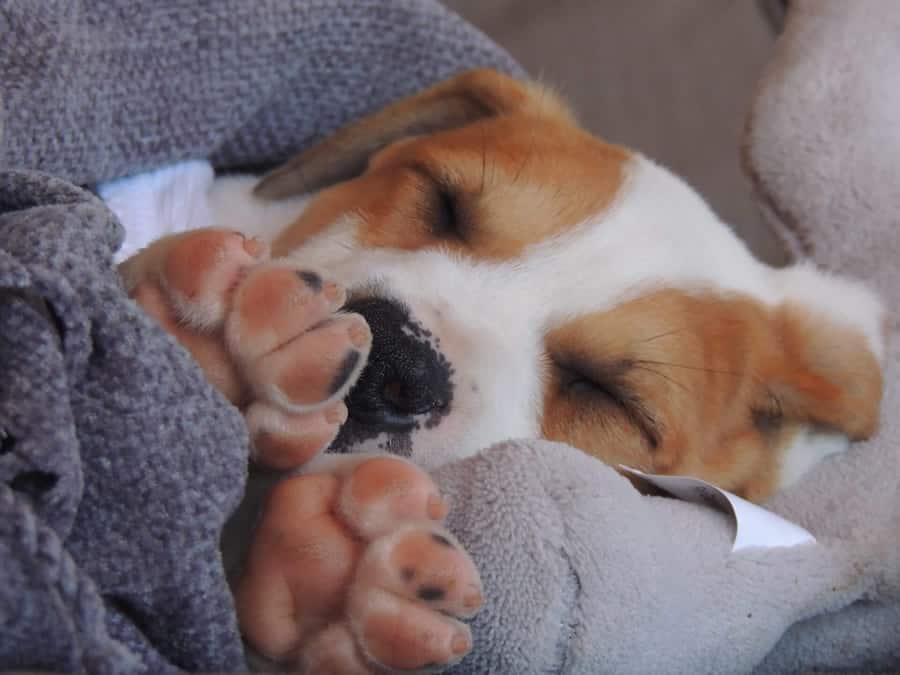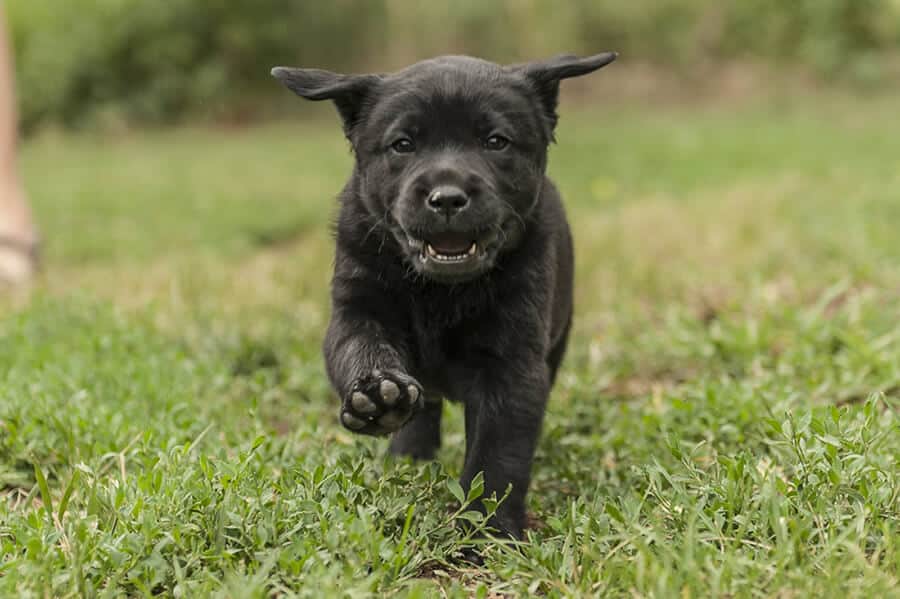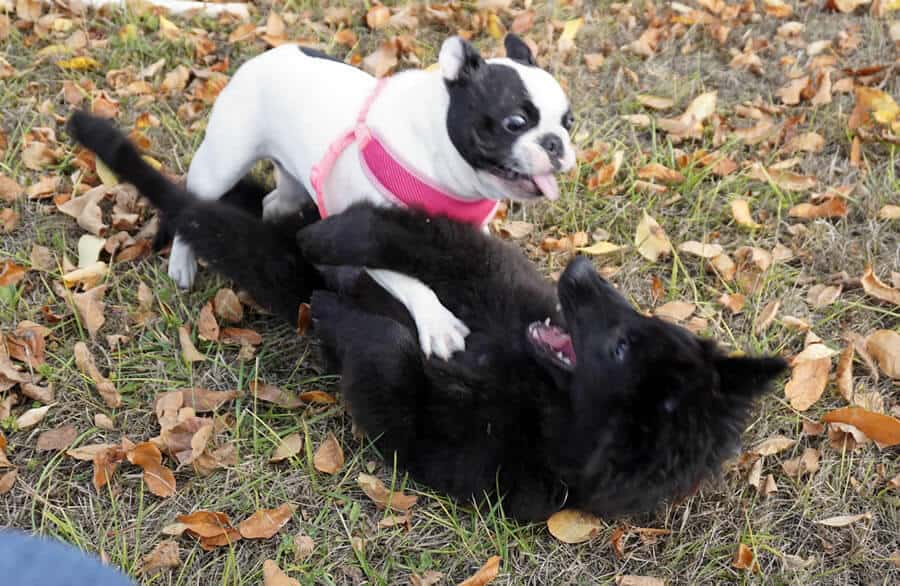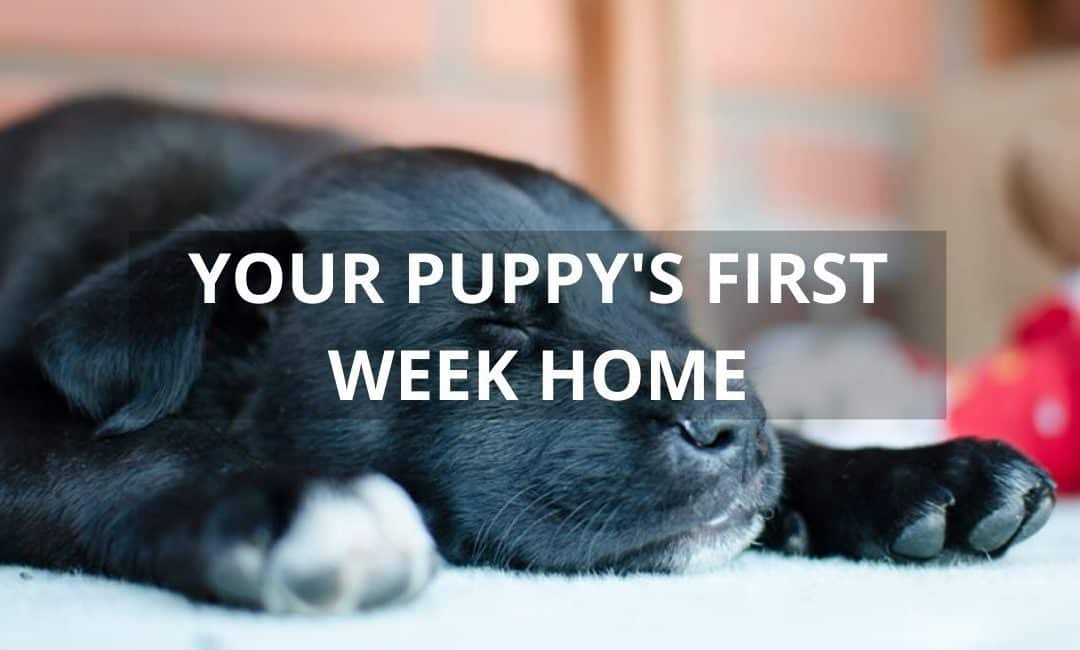A new puppy! There aren’t many things in life that can offer such a thrill of possibility or sense of potential. With that in mind, we offer this special FAQ for new puppy owners, all about Your Puppy’s First Week home (plus a little beyond). From preparing your pup for the trip home, to house-training, to socializing your puppy, to beginning obedience training, and even puppy developmental stages – we’ve got you covered.
How old should my puppy be when I bring him home?
It’s critically important to realize that puppies need to stay with their mother and littermates through 7 weeks old, at minimum.
Staying with mom and littermates during the 5-7 week period is vital. This is when puppies learn social lessons on how to control the intensity of their bite (through play with littermates), how to accept discipline and respond to it properly (through discipline from the mother), and how to correctly interpret canine body language.
Pups placed in homes before going through this stage tend to play-bite harder and have exaggerated reactions to frustration. They have poor dog-to-dog communication skills.
Their lack of understanding canine body language can lead to a host of problems – inability to play properly, fear, over-excitement, or even aggression toward other dogs.
Another consideration is that 7 weeks is the age when most experienced breeders and animal professionals believe that puppy aptitude and temperament testing is the most reliable.
If your breeder or rescue organization is doing one of these tests to help determine which puppy will be best for you, placement would be at or after 7 weeks old.
That said, oftentimes pups will do better going home somewhat later than 7 weeks old, provided the breeder is equipped to train and socialize the litter. With my own breed (Belgian Shepherds), I find 9 weeks to be a good age. At 9 weeks the pups are generally emotionally ready and eager to make the transition and to bond to new owners.
Some of the smaller breeds can take longer to mature physically, and may adjust more easily – and housetrain more readily – when they are placed at 10 or even 12 weeks of age.
But I feel it’s important to say that a prospective puppy adopter needs to take extra precautions if bringing home a puppy at a later-than-usual age. While it’s always important to make sure your pup received thorough socialization, it’s absolutely critical in puppies placed past about 9 weeks old.
If the pups are left to themselves, just hanging out in a pen with their littermates for those extra weeks, think twice (or more) before taking home that pup. Puppies left too long like this have a harder time forming a bond with their new families. They tend to get very competitive and play much rougher (and those habits can remain lifelong). Additionally, the shock of having to deal with the wide world can come as traumatic. Some pups never fully adjust to life in their new home.
If your breeder or rescue group intends to keep their pups past 8 or 9 weeks old, do yourself a huge favor and make absolutely sure they will be actively socializing the pups individually. They must be committed to taking the time to regularly and thoughtfully introduce each pup individually to new sights, sounds, surfaces, people, animals, and places.
The puppies shouldn’t be kept together night and day, but separated out with designated play periods together. Housetraining and crate training should be begun.
As you can imagine, this is a HUGE job, and very time-consuming. Only the most conscientious breeders and rescue groups will go to the trouble.
What’s the best way to prepare a new puppy for the trip home?
To reduce stomach upsets, bring water along from the breeder’s home, and be sure the puppy is not fed for several hours before your trip. Your pup will be more comfortable traveling slightly hungry than on a full, queasy stomach!
If traveling by car, your pup can be held on a passenger’s lap if the ride is short, or can alternate between crate and lap if the ride is longer. If you’re traveling alone, a crate will be your best and safest solution. (Ideally your pup’s breeder will have introduced the puppy to a crate prior to being sent to his new home.)
Bring a blanket or two, a roll or two of absorbent paper towels, and some resealable plastic bags to put clean-up materials in (puppies rarely get sick or have an accident near a waste bin!). If using a crate, line the pup’s crate with a thick layer of separated paper towel sheets, using one full roll of sheets for a medium sized crate. If your puppy has an accident or gets sick while traveling, this makes clean-up so much easier, as well as keeping the majority of the mess off the pup!
Plan to make a bathroom stop every 30 minutes or so along the way. Your puppy should always be on leash for any bathroom breaks. A good rule is that no car door opens until the leash is securely fastened and in someone’s hand.
It is so easy for a pup to be out the door before anyone realizes. In a strange area, a puppy new to you may not stay with you or come back to you, and a moment of panic could cause him to get injured or lost.
Finally, be sure your pup has some sort of visible identification. Yes – even if your puppy was microchipped while still with the breeder. Without a visible tag, many people finding a puppy will assume it’s been abandoned.
If you haven’t had a chance to have permanent tags made, you can make your own temporary tags. I make traveling tags on my computer, somewhat over-sized (and therefore more easily noticed) at about 2″ x 3″ in size. These are printed with my name and a few contact numbers, and something along the lines of “If I Am Alone, I Am Lost!” printed in bold red type, on the front. I cut these out, have them laminated, and punch a hole through the plastic near the top of the tag.
This gets attached to each pet’s collar, whenever I am traveling with my dogs or cats. While no form of ID is perfect, an easily seen tag on your puppy will help make sure no one assumes he is abandoned or wandering, in case something unforeseen happens, and he does manage to get away from you.
Any recommendations for when we first arrive home with the puppy?
Give your pup some time to relieve himself outside first, before bringing him inside. If he’s too distracted and doesn’t go, take him inside, but carry him, or only set him down for brief periods, then take him back outside.
It’s important that any elimination gets done in what is to be his regular potty area, or at the very least outside, that first time.
Once your pup has relieved himself, feel free to allow him to explore a bit – carefully supervised, of course! He doesn’t need to see the whole house, but an exploration of the main living areas will help him orient and adjust.
It’s fine, then, to offer a drink of water, but hold off on giving any food for now. Your pup will most likely need a nap after all the excitement, and very likely his stomach won’t be ready for food until after that.

How do I start housetraining a new puppy?
Need housetraining tips for your puppy’s first week home? Three important things to remember about housetraining are: Schedule, Supervise, and Reward the response you like.
Feed meals at regular, predictable times every day. It’s best to avoid free feeding, since a puppy who eats at random times during the day will need to “go” at random times during the day. A puppy on a regular feeding schedule will also get on a regular schedule of elimination.
Your puppy must go out immediately upon waking up, then out after every meal, when he wakes up from naps, and after play. Train yourself to watch for telltale signs of needing to potty: sniffing, circling, hunching; a sudden burst of activity can indicate a need to defecate.
Don’t count on a baby puppy knowing how to come and get you, or go to the door. Over time, you and your pup will figure out how to communicate those needs, but for now, be ready to take him out at any sign!
Housetraining is really a habit, as opposed to a conscious choice. Your puppy’s first week home, I recommend getting your pup’s bodily functions on a regular schedule, and concentrating on establishing the habit you want your pup to get into – relieving himself, for example, only on grass, or gravel, etc.
Be generous in your praise for all good efforts outside, and try not to draw attention to accidents inside. If you see the pup start to go, by all means interrupt him, with a noise or by scooping him up, and get him outside to his potty area to finish. Don’t go so far as to frighten him, and do not punish him!
Housetraining is a learning process, one that counts on your pup being able to trust you; he must want to seek you out when he needs to go. A pup who fears punishment for his mistakes is much more likely to simply avoid you when he feels the urge to go.
How soon can I start expecting a puppy to be reliably housetrained?
There is really no set age or time frame for a puppy to become reliably housetrained. Once the puppy becomes reliable when you are diligently supervising, you can start relaxing your supervision for a few minutes at a time. This may be a couple of weeks, or a few months, after you bring your puppy home.
Avoid relaxing your restrictions too soon – even after your pup develops physical control, he will still have the attention span of a puppy, and may get caught in the back of the house, with no way to communicate to you that needs to go out.
If he gets a chance to discover that the back bedroom is a handy alternative bathroom, this could be a major setback to all your hard work and diligence.
I prefer to keep up strict supervision for about a month after the last accident, before I begin to ease up – very gradually! Keep supervising and you’ll avoid your pup developing bad habits.
Any other you have any other tips or tricks that can help make this a success?
First, be sure to read my step-by-step guide to housetraining any new puppy or dog.
Then, be consistent, develop a routine, and be diligent in your supervision. Have some confinement options available for when you can’t supervise, or just need a break :-).
Don’t take good behavior for granted — actively let your puppy know that you appreciate every desirable behavior you get from him.
Realize that both you and your pup will make mistakes! He’ll be patient with you, if you are with him. Determine to have fun, take the occasional bumps in stride, and most of all, enjoy your puppy!
Where should my puppy sleep? Is there a best way to handle loneliness and crying?
I feel the absolute best place for a dog to sleep is right next to your bed. For your puppy’s first week home (and beyond), you can place his crate there, next to you. (You could also use a small exercise pen.)
I like to have the crate close up by the head of the bed, so I can hear him if he stirs, and I can easily reach down and put my fingers through the crate door, so that the puppy can sniff or lick my fingers. Especially the first few nights, it can really help the puppy if you make that contact, and just let him know someone is there!
You can also keep a toy or blanket from the breeder’s home in the crate, which smells like mom and littermates, or you can use the old standby hot water bottle wrapped in a fluffy towel, for those first few nights. But nothing takes the place of good old-fashioned human contact.
Having the puppy sleep in your bedroom has two additional benefits. The puppy learns from watching you that nighttime is for sleeping, not activity, and if he needs to go out to potty, you’ll know about it right away.
Pups that are kept in a separate room at night, or are loose to roam around the house, may find less-than-ideal ways to entertain themselves and relieve loneliness and boredom. Unconfined at night, pups may learn to chew or dig at walls and furniture, even on electric cords.
With no one awake to supervise, this is at best a quick way to develop some very bad habits, and at worst, a dangerous situation to put your new puppy in! You’ll save time, trouble, and money by investing in, and using, a crate or exercise pen for your new puppy.
Should I give my puppy full run of the house right away? What’s the best way to supervise and introduce him to the entire house?
Puppies are naturally curious, and like babies, want to put things in their mouths to find out about them. Their attention spans are short, and even the best puppy may find its curiosity getting the best of him!
For most puppies and even adolescent dogs, having the run of the house, unsupervised, is simply too much temptation, and too much responsibility.
Bear in mind that it can be very difficult and time-consuming to teach a dog to stop chewing inappropriate items, like your favorite shoes and that expensive imported rug, after he has discovered what fun toys they can be, and developed a habit of chewing them.
Puppies of different breeds, and even pups within the same litter, mature at different rates, and will be able to be responsible with free run of the house at different ages. I like to err on the side of caution for the pup’s first year! Supervise closely, and confine when you can’t.
Close doors or use baby-gates to block off off-limits rooms and areas of the house. Pick up, or apply taste-deterrent to, any tempting items, and provide your pup a selection of chew toys of different shapes, sizes, and textures.
Let him know what a wonderful pup he is when you “catch him in the act” of chewing his own toys! And distract him from chewing those things you weren’t able to prevent him from investigating.
Puppies have a physical need to chew while they are teething, and then after teething, when the teeth are “setting” in the jaw.
The main challenge is getting through your pups first 7-8 months without allowing him to develop the habit of chewing forbidden items. Once he is past the chewing stage, most pups can have their freedom in the house increased gradually but steadily.

What’s the best way to introduce a new puppy to my immediate family? What about friends, relatives and neighbors?
Some puppies will walk into their new home and act as if they’ve lived there all their lives, and with those pups it’s easy. Other pups will experience more stress upon the change in environment, and will take a bit more time to become confident.
For most pups, it’s best not to overwhelm with introducing large numbers of people at once that first week home. Children should be taught to walk, not run, around the puppy, and to talk normally, and not to scream or squeal.
This should be covered and understood before the puppy comes home.
If you have a large family or lots of frequent visitors, try to arrange to have them meet the puppy a few at a time, rather than all at once.
Keep greetings and play calm and gentle – don’t allow well-meaning family or visitors to overwhelm or agitate the pup. Remember that with every interaction he is learning how to behave around people, so it’s worthwhile being sure he is learning to be calm and relaxed versus wild and out of control.
Your pup also will need a place where he can be allowed some quiet time, before he gets overwhelmed or over-tired with the excitement of company. An exercise pen or playpen can be very helpful for this.
When and how do I start regular training with a new puppy? Is this something I can start my puppy’s first week home?
Young puppyhood is an age of intense learning. Why not get in there and teach some things, right off the bat that will enhance your communication for years to come? Besides, it’s fun, and a great way to bond with your pup and develop some lines of communication.
You can’t go wrong starting with the basics: your pup should learn his name, and to give you his attention when he hears it; come when called; off (no jumping); sit; walk on leash; to go in his kennel when asked; a pottying cue such as “hurry up” or “do your business”.
These are examples of things your pup can start to learn from day one in your home, using repetition, praise, and positive reinforcement.
When should my puppy attend puppy kindergarten class?
Your veterinarian is your best guide for when a pup should attend puppy kindergarten. You want to go early enough to take advantage of the window for socialization, but not so early that his immune system is not able to withstand the typical puppy viruses he may get exposed to in a class situation with unknown dogs.
Incidence of contagious puppy diseases varies by area and by time of year. Your veterinarian will have the most current info and best advice on when you can safely start classes.
Do I need to take my new puppy to the veterinarian, even if he seems healthy?
New puppy owners should take their pup to be examined by their veterinarian within 3 days of bringing the pup home. This is very important to be sure there were no diseases or other health issues present when you acquired the pup.
Many breeders who guarantee their pups have this early vet visit as a requirement for the guarantee. Additionally, a responsible breeder will want to be notified if there are any health problems, so that she can inform other puppy buyers of any potential problems.
Now, if at all possible, I prefer not to vaccinate or do anything potentially unpleasant on that first visit. This first time at the veterinarian’s will tend to form your pup’s opinion of vet visits in general, so I want it to be as gentle and positive an experience as possible. So, I prefer to do no vaccinations, and no nail trimming, etc., on the first visit.

I like to give a few days to a week to allow the pup to adjust to its new surroundings and family. Keep in mind that your pup’s sociability and outlook can depend upon many factors, only two of which are heredity and early experience at the breeder’s home.
Recent worming or vaccinations can make a pup tired and less than interested in new, possibly frightening experiences. Cutting teeth can make a pup grumpy and unsettled. After a long plane flight, a pup may take several days to regain his equilibrium and attitude.
Exposing your new puppy to too much at any of these times can cause him to be overwhelmed and taxed, rather than enriched by the experience.
It’s important to keep in mind, first and foremost, that socialization is not simply about exposing your pup to new experiences (people, places, sights, sounds, etc.), but is really about creating what I think of as positive “imprint experiences”.
A puppy’s first exposure to anything new will create a “first impression” or imprint that can color his view of that type of experience from then on.
With that in mind, make a conscious effort to set your pup up for success on his socialization outings. Aim to introduce him to a variety of sights, sounds, smells, footings, as well as different types of people, dogs, and other animals.
Encourage and praise curiosity and investigation. Keep in mind that every pup is unique, and try to keep your pup within his comfort level for new experiences.
If he is unsure of something, don’t baby him, but also don’t force him to approach if he is not ready.
Instead, you can casually move away a little, and allow him to observe from a greater distance. If he becomes brave and wants to investigate, good. If he isn’t ready, don’t worry, just try another day.
It’s okay – no puppy is 100% brave and confident 100% of the time!
I’ve heard that puppies go through certain “developmental stages” as they mature. What should I be aware of?
Depending on the age you bring your puppy home, most likely the first developmental stage you pup will go through is the “fear imprint” stage.
During this stage, which begins at 8 weeks, and lasts till approximately 11 weeks old, your puppy will tend to stick close, “following at your heels”.
This is not a fearful stage; there is no reason to expect your outgoing, bold pup to suddenly become timid or tentative.
Instead, it is a developmental period which a puppy is prone to imprinting on significantly frightening or startling experiences, retaining a fearful reaction for life.
Of course, what is significant really depends on the puppy’s perspective at the time. For example, say an 8 week old pup, just entering the fear imprint stage, is badly startled by a child who has snuck up behind him, popping a balloon loudly over the puppy’s head.
There is a chance this will cause a fear imprint, but what exactly the puppy may become fearful of is difficult to predict. It could be that child, children in general, balloons, loud noises, objects hovering over his head, things coming up behind him, or some other factor that the pup focused on in his fear.
Essentially, the “fear imprint” stage is one in which a truly traumatic experience can affect your pup for life. Most pups will not experience anything traumatic at this age, but it’s worth taking basic precautions to avoid unnecessary scares.
At 11 to 12 weeks, as pups emerge from the fear imprint stage, they suddenly seem to gain confidence and independence. The puppy that once only had eyes for you, discovers other priorities!
This is a natural stage for all pups to go through, and doesn’t mean that your pup has begun to challenge your authority. This is, however, a very good time to increase your reinforcement of Come and basic name attention ?
At 16 weeks, your puppy’s brain is capable of learning anything an adult dog can learn, although attention span and physical coordination are yet to come.
At approximately 6 months old, puberty hits. From then until as late as 18 months, your pup is officially a teenager! He is looking more and more like an adult, but only occasionally acting like one. Hormones can wreak havoc with the best teenager’s (dog or child) behavior.
Like human teenagers, most adolescent pups will, in some way or other, try to push their boundaries. This is a normal testing process, and part of growing up. This is a good time to review your house rules, and make sure the whole family is on the same page, and consistent with expectations. It’s also a smart time to enroll in a positive obedience course, as a refresher for both you and your pup.
I wish you the best of luck at this exciting time. May your new puppy bring you lots of joy. And if you liked this article, would you please share it with your friends? Thank you!
Best,
julie
(bio)




